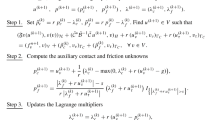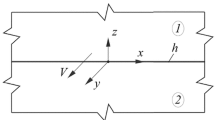Abstract
We describe a method of determining the thermal conductance of a contact in simulation of contact thermoelasticity with regard for friction and heat generation. Using the results of numerical analysis, we construct the dependence of the thermal conductance of a contact on input parameters and show that some of them substantially affect this phenomenon. By the example of a one-dimensional nonstationary problem, we study the effect of the parameters of contacting surfaces on heat generation.
Similar content being viewed by others
REFERENCES
V. P. Baran, A. G. Vardzal', V. M. Onyshkevich, and I. T. Vas'kevich, "A quasistatic contact problem of thermoelasticity for two semiinfinite bodies with regard for heat generation at the interface," in: Modern Problems of the Theory of Contact Interactions [in Russian], Izd. Akad. Nauk Arm. SSR, Erevan (1988), pp. 24-26.
D. V. Hrylits'kyi and V. P. Baran, "On the statement of contact problems of thermoelasticity with regard for heat generation in the case of nonideal thermal contact between bodies," Visn. L'viv. Univ., Ser. Mekh. Mat., Issue 27, 10-13 (1987).
V. I. Danilovskaya, "On a dynamic problem of thermoelasticity," Prikl. Math. Mech., 16, No. 3, 341-344 (1952).
A. D. Kovalenko, Thermoelasticity [in Russian], Vyshcha Shkola, Kiev (1975).
M. V. Korovchinskii, "A plane contact problem of thermoelasticity in the case of steady-state heat generation at the contact surface," in: Contact Strength of Engineering Materials [in Russian], Nauka, Moscow (1964), pp. 2-27.
Ya. S. Pidstryhach, "The temperature field in a system of solids conjugated with the help of an intermediate layer," Inzh.-Fiz. Zh., 6, No. 10, 129-136 (1963).
Ya. S. Pidstryhach and P. R. Shevchuk, "On the effect of surface layers on the diffusion process and a stressed state in solids conditioned by it," Fiz.-Khim. Mekh. Mater., 3, No. 5, 152-157 (1967).
Heat Exchanger Design Handbook [Russian translation], Vol. 1, Énergoatomizdat, Moscow (1987).
R. N. Shvets and R. M. Martynyak, "Thermoelastic contact interaction between bodies in the presence of surface thermophysical inhomogeneities," Mat. Metody Fiz.-Mekh. Polya, Issue 27, 23-28 (1988).
T. N. Cetinkale and M. Fishenden, "Thermal conductance of metallic surfaces in contact," in: General Discussion of Heat Transfer: Proc. Inst. Mech. Eng. and ASME (1951), pp. 271-275.
M. Godet, "Third-bodies in tribology," Wear, 136, No. 1, 29-45 (1990).
T. N. Veziroglu, "Correlation of thermal contact conductance experimental results," Prog. Astro. Aero., 20, 1-12 (1967).
Author information
Authors and Affiliations
Rights and permissions
About this article
Cite this article
Levyts'kyi, V.P., Onyshkevych, V.M. Investigation of the Influence of Properties of a "Third Body" on Heat Generation Due to Friction. Journal of Mathematical Sciences 109, 1251–1256 (2002). https://doi.org/10.1023/A:1013752929389
Issue Date:
DOI: https://doi.org/10.1023/A:1013752929389




